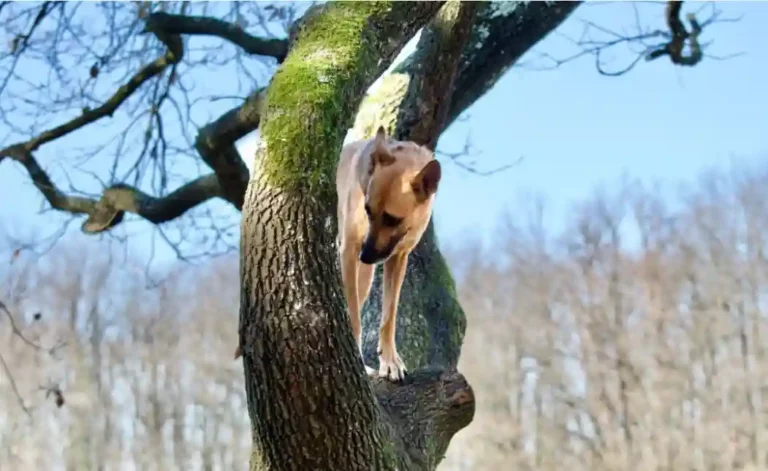12 Clear Signs Your Dog’s Labor Is Imminent
Your pregnant dog’s due date is just around the corner. Her whelping box is prepped, and you’re eager to meet the puppies. But how will you know exactly when she’ll go into labor?
Watch for these 12 signs in the final days of your dog’s 63-day pregnancy that indicate whelping is imminent:
- Nesting – She may find the perfect spot to give birth and gather blankets and toys. This nesting instinct kicks in 1-2 days before labor.
- Drop in Temperature – Your dog’s temperature will drop to 98-99°F, down from her normal 101-102°F approximately 24 hours before labor starts.
- Lack of Appetite – She’ll refuse her favorite treats and meals when labor is close.
- Vaginal Discharge – Look for a clear or slightly bloody discharge up to 48 hours prior.
- Restlessness – She may seem anxious, constantly getting up and down. Panting and shivering can also signal impending labor.
- Enlarged Teats – Her mammary glands will enlarge significantly in the last week.
- Digging – She may try to dig up her whelping area or the yard, looking for the ideal spot.
- Seeking Seclusion – Your social dog may suddenly prefer to be alone, hiding in her safe space.
- Nursing Stuffed Toys – A dog’s maternal instincts may lead her to practice nursing on toys.
- Clinging Behavior – Your independent pup may suddenly need to be by your side for comfort.
- Contractions – Abdominal and uterine contractions will start 6-12 hours before whelping.
- Water Breaking – Release of the amniotic sac signals labor is starting within 24 hours!

Once you notice these signs, alert your vet and prepare for the big day! Call your vet immediately if you see strong contractions or straining for over 1 hour with no puppy. With preparation and awareness of these 12 signs, you and your dog will be ready for her smooth labor and delivery in the next 24-48 hours! Here is an expanded section on the temperature drop sign.
Table of Contents
- Sudden Drop in Body Temperature Signals Imminent Labor
- Nesting Instincts Emerge Up To 48 Hours Before Labor
- Food Aversions Signal Impending Labor Within 48 Hours
- Loose Stools Indicate Impending Labor Within 24 Hours
- Enlarged Mammary Glands Indicate Welping Within Days
- Fatigue In Late Pregnancy Signals Impending Labor
- Restlessness and Clinging Behavior Foreshadow Imminent Labor
- Heavy Panting Signals Active Labor is Close
- Shivering Indicates Labor Will Start Within Hours
- Visible Contractions Indicate Active Labor is Underway
- Pushing Signals Delivery is Imminent
- Appearance of Amniotic Sac Signals Puppy Arrival Within Minutes
- Prepping for Puppy Arrival: Must-Have Welping Supplies
- What to do when your dog starts whelping?
- Signs that indicate you should call your veterinarian immediately during your dog’s labor
- Subsequent puppy births after the first puppy arrives
- Common complications that can arise during canine labor and delivery
- Do dogs have a discharge before labor?
- Do they leak before giving birth?
- Do female dogs usually give birth at night?
- Conclusion
Sudden Drop in Body Temperature Signals Imminent Labor
Temperature: One of the most reliable signs that your dog’s labor is approaching within 24 hours is a sudden drop in her average body temperature.
In the last 2-3 days of your dog’s 63-day pregnancy, begin taking her rectal temperature twice daily. Average canine body temperature ranges between 100-101°F (37.7-38.3°C).
However, in the final 24-48 hours before labor begins, watch for her temperature to plunge below the normal range, dropping to 97-99°F (36.1-37.2°C). Once her temperature hits this lower range for more than 24 hours and stays below 100°F, you can expect strong contractions and labor to start within the next 12-24 hours as her temperature continues declining.
This temperature drop indicates that hormones are surging in preparation for imminent whelping. Don’t be alarmed if her temperature fluctuates slightly during this pre-whelping time.
Just monitor closely for it to drop and remain below 99°F for over 24 hours to signal that birth is less than a day away! Let’s find some more details about the nesting behavior sign.
Nesting Instincts Emerge Up To 48 Hours Before Labor
Nesting Instincts: One of the first signs that whelping is approaching within 48 hours is when your previously relaxed dog suddenly begins exhibiting intense nesting behaviors.
Once your dog’s hormone levels shift as labor nears, her natural maternal instincts will kick in, and she’ll start seeking out the ideal place to birth her puppies.
You may notice her frantically digging at blankets in her bed to fluff them up. She may also drag over towels, pillows, or dog toys to create a nest area up to 2 days before active labor begins.
Some dogs specifically target their owner’s pillows or laundry piles to gather materials for their nesting spot. To prepare, set up a whelping box or nesting area for her ahead of time.
However, even with a cozy prepped space, your dog’s primal nesting urges will likely still have her urgently searching for the perfect birthing nest in the final 48 hours. Satisfy her instincts by providing soft blankets and let her dig away!
Food Aversions Signal Impending Labor Within 48 Hours
Has your pregnant dog suddenly lost interest in her favorite meals? Does she turn up her nose at tasty treats? This loss of appetite is expected in the final 48 hours before labor begins.
Around this time, the puppies will drop lower in her birth canal, putting pressure on her stomach and intestines. She may even vomit whatever little food she consumes due to gastrointestinal distress.
Some warning signs in the last 2 days of pregnancy that her appetite is waning:
- She leaves her full food bowl untouched at mealtimes
- Refuses high-value treats like chicken, cheese, or hot dogs
- Takes only a few bites and then walks away from the bowl
- Regurgitates food immediately after eating
Don’t worry if your dog skips a few meals and isn’t drinking much in the imminent pre-labor period. Just make sure fresh water is always available to her. Ice cubes are a good way to hydrate as well.
Once she gives birth, her appetite should return to normal within a day or two. In the meantime, the most important thing is keeping her comfortable and preparing for the exciting delivery!
You need to know some additional details about bowel movement changes before labor.
Loose Stools Indicate Impending Labor Within 24 Hours
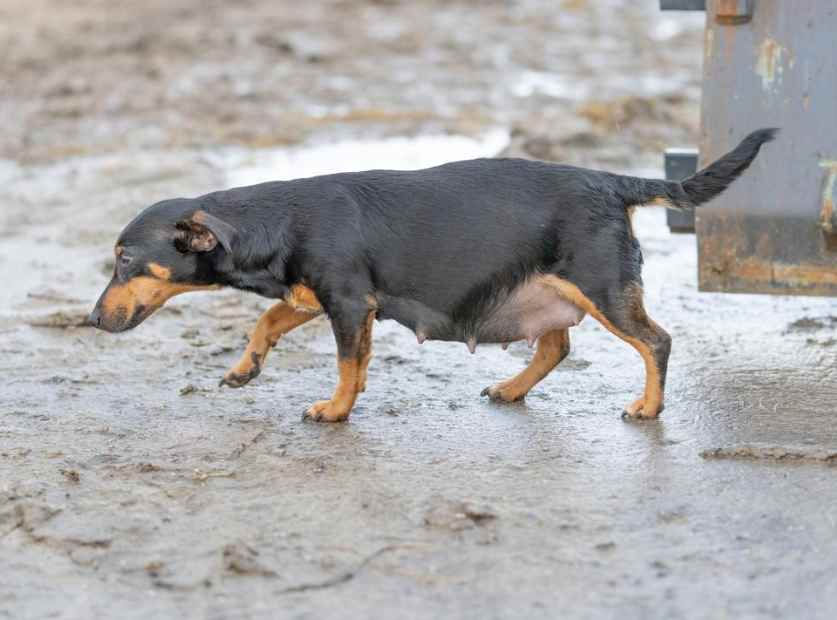
In addition to appetite changes, your pregnant dog may have larger, looser bowel movements in the last 24 hours before labor begins.
As the puppies drop lower in the birth canal, it puts pressure on your dog’s rectum, colon, and intestines. This often results in loose stools or diarrhea due to disrupted digestion.
Some signs to look for:
- Large and loose stool volume
- Frequent bowel movements
- Straining but only passing liquid feces
- Intestinal gurgling, gas, and discomfort
Don’t be alarmed by this temporary change if your dog is acting normally. Make sure she has plenty of fresh water to stay hydrated.
You can plan for the puppies’ arrival within the next 24 hours once you notice this sign of imminent whelping! Call your veterinarian if she appears distressed or unable to pass stool. Otherwise, get ready for labor soon!
Enlarged Mammary Glands Indicate Welping Within Days
In the final week before your dog goes into labor, you’ll notice her nipples becoming enlarged and milk production starting as her body prepares to nourish her puppies.
- Her mammary glands will appear swollen and reddened and may feel warm to the touch
- A yellowish or milky fluid discharge is expected at this stage
- Her nipples will enlarge and protrude noticeably
This mammary development happens thanks to prolactin and oxytocin surging in her system around 7-10 days pre-whelping.
While some swelling is normal, alert your vet if you notice any heat, hardness, or excessive discharge from the glands. Otherwise, take it as a clear sign that your dog’s peak lactation is coming, and new puppy mouths to feed very soon!
Fatigue In Late Pregnancy Signals Impending Labor
Has your energetic dog suddenly turned into a couch potato? Excessive resting and lethargy in the final week of pregnancy indicate she’s conserving her energy for labor.
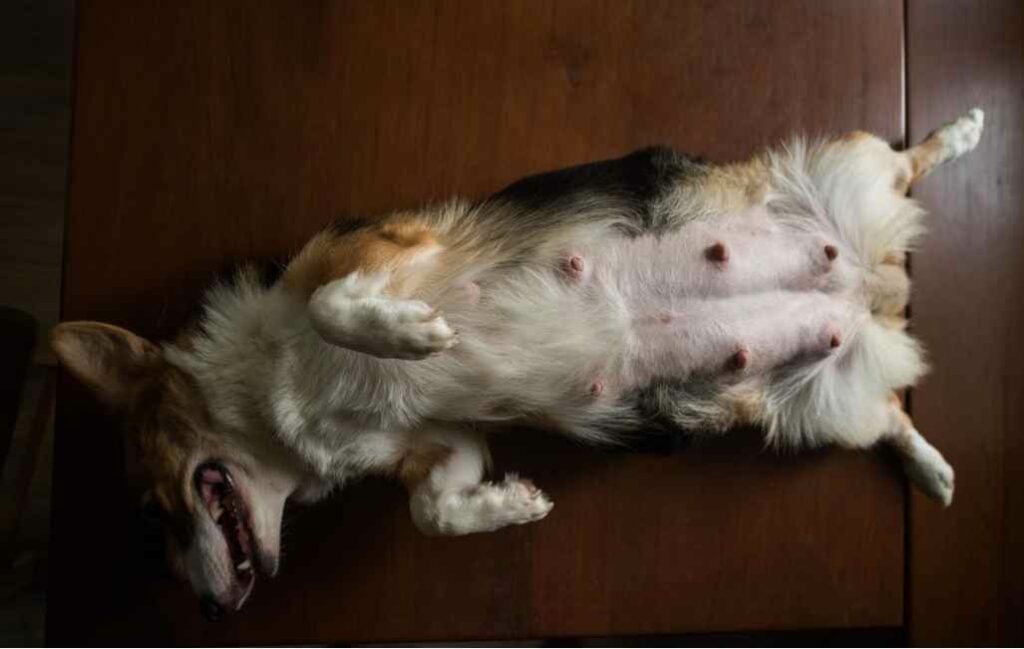
Signs your dog is significantly slowing down as her due date nears:
- Sleeping up to 20 hours per day
- Moving slower on walks
- Loss of interest in playtime or exercise
- Seeking out cozy, quiet spaces to lie down
This fatigue happens as progesterone levels drop in the last week before labor. Your dog’s body knows it will need strength for the hard work of whelping, so it’s telling her to save her energy.
It’s normal for your dog to sleep more, move less, and just take it easy as she prepares for delivery. Let her get all the undisturbed rest she needs before her puppies arrive in just a few days! If fatigue persists post-whelping, contact your vet.
Restlessness and Clinging Behavior Foreshadow Imminent Labor
In the final stage, before active labor begins, you may notice your previously calm dog becoming “restless, anxious, and needy.”
Signs your dog’s whelping is likely within 12-24 hours include:
- Pacing or inability to get comfortable
- Excessive panting without exercise
- Seeking constant attention and reassurance
- Following you closely room to room
- Crying or whimpering for no clear reason
Your dog’s instincts tell her she’ll need your support through the birthing process, so she may cling to you and always want to stay by your side. Her restlessness is due to hormonal changes, making her uneasy as contractions approach.
Respond to her needs for comfort, and don’t leave her alone in the last hours before hard labor begins. Pet her, speak softly, and provide a safe space where she can settle in until it’s time for puppies to arrive soon! Stay calm and be prepared.
Heavy Panting Signals Active Labor is Close
One of the clearest signs that your dog is entering the first stage of labor is sudden heavy, rapid panting, even when at rest.
Here’s what to expect:
- Panting becomes frequent and fast-paced, exceeding 60+ breaths per minute
- Their nostrils flare as they inhale and exhale swiftly
- The tongue likely hanging out during deep breathing
- Panting persisting for an hour or more
- Pausing briefly, then resuming intense panting
Excessive panting is triggered by a sharp rise in hormones like cortisol and norepinephrine as labor nears. It helps manage your dog’s pain and stress.
Once you notice this sustained forceful breathing pattern, labor will likely start within 2-4 hours as your dog’s cervix dilates. Be prepared to comfort her through each contraction until the puppies arrive soon!
Shivering Indicates Labor Will Start Within Hours
After your dog’s temperature drops below 99°F for over 24 hours, you may notice her shivering and shaking even in a warm room in the final hours before labor.
This temperature spike and shivering occur for two key reasons:
- Her temperature rises to 98-100°F right before active labor begins due to surging hormones.
- The whelping muscles start contracting, which leads to shivering and tremors.
Other signs your dog is cold and shaking as labor nears:
- Constantly readjusting as if she can’t get comfortable
- Teeth chattering
- Seeking out warm spots to burrow into
This is a definite sign hard contractions are imminent within the next 2-12 hours. Have whelping supplies ready and comfort your soon-to-be mama! Keep her area draft-free and cozy. The puppies are almost here! Let’s learn about contractions signaling the start of labor.
Visible Contractions Indicate Active Labor is Underway
The most definitive sign that your dog is in labor is when you see strong contractions rippling across her belly as her uterus tightens.
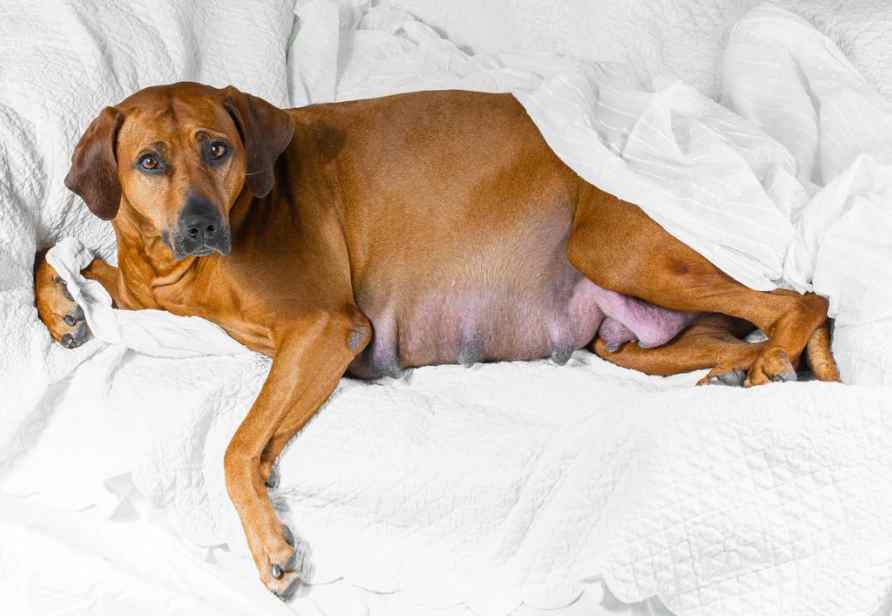
Here’s what to look for:
- Repeated hardening of the abdominal muscles every 5-30 minutes
- Lasting 45-60 seconds per contraction initially
- Her belly will tense up, feel firm, and may appear rippled
- She may cry out or become restless during contractions
- Intervals between contractions shorten as labor progresses
Active whelping is underway once contractions are regular, intense, and continuing to strengthen. Time the intervals between them. Call your vet if straining lasts over 1 hour with no puppy. Otherwise, offer reassuring pets and prepare to meet the puppies soon! Her contractions will become more frequent and pronounced as delivery nears.
Pushing Signals Delivery is Imminent
Once your dog’s cervix is fully dilated after hours of contractions, she’ll enter the second stage of labor and begin actively pushing to expel puppies.
Signs the pushing stage is underway:
- Intense contractions continue every 2-5 minutes
- Straining and bearing down with her abdominal muscles
- Appearing to crouch or squat to push
- Strong urges to push lasting 5-30 seconds during contractions
- Possible vocalizations from effort; may look distressed
Pushing typically starts about 30-60 minutes before the first puppy emerges. Let your dog follow her instincts to make without interference. Once you see the sac bulge from her vagina, birth is imminent within 15-30 minutes!
Stay calm and offer gentle encouragement. Panting and light pushing helps pace her pushing stage. Call the vet if she pushes hard for over 1 hour with no puppy. Otherwise, get ready to meet her puppies soon!
Appearance of Amniotic Sac Signals Puppy Arrival Within Minutes
One tell-tale sign that a puppy is positioned to arrive immediately is the appearance of the amniotic sac bulging from the vaginal opening.
Here’s what to look for:
- A fluid-filled translucent membrane emerging during strong contractions
- The size of a grapefruit when fully protruding
- Ruptures shortly after being visible, releasing warm amniotic fluid
Once the sac containing protective fluids appears, prepare for a puppy to be delivered within 15-30 minutes. This occurs when the first puppy is positioned in the birth canal, ready to emerge after the cervix fully dilates.
The thin membrane will eventually rupture, flowing the fluids out. This “water breaking” signals the pup’s head will emerge through the vaginal canal next as your dog continues pushing! Exciting puppy time is finally here!
Prepping for Puppy Arrival: Must-Have Welping Supplies
The big day is approaching fast! Make sure you have these essential supplies on hand before your dog goes into labor:
- Whelping box – A cozy nesting area with low entry sides where she can safely deliver. Line it with blankets/towels.
- A heating pad or lamp – Maintains a warm 95°F ambient temperature for newborn puppies. No direct heat.
- Digital scale – To weigh puppies in grams/ounces immediately after birth. Ensures they are nursing properly.
- Bulb syringe – If needed, suction fluids from puppies’ mouths/noses right after delivery.
- Thermometer – Monitor mom’s temperature for impending labor drops. It is also helpful in monitoring puppy temperature.
- Formula & bottles – Supplemental feedings if the mother dog can’t produce enough milk.
- Vet’s phone # – Program your veterinarian’s emergency contact information into your phone in case of any delivery complications.
- Towels – For drying off and warming puppies after birth. It can also be used to transport puppies safely.
- Dental floss/scissors – To tie off umbilical cords 1 inch from the body after birth.
With these essential supplies, you and mom will be fully prepared for a smooth whelping when the puppies arrive!
What to do when your dog starts whelping?
When your dog starts whelping, notify your veterinarian that labor has begun, and keep their number handy in an emergency. Provide a “quiet, comfortable, and clean environment” for your dog to give birth. Place towels or blankets in the whelping box.
- Let your dog follow her natural mothering instincts as much as possible during birthing. Do not interfere unless she needs help.
- Be patient – labor can take 2-12 hours from the time contractions start until the last puppy is born. This is normal.
- Make sure the newborn puppies are breathing right away. Gently wipe fluid from their mouth and nose with a towel if needed.
- Monitor that the mother removes the sac and cleans the placental membranes from each pup within 2 minutes of birth. If not, you can tear and remove them yourself.
- Tie off umbilical cords with dental floss 1 inch from the puppy’s belly and cut with sterilized scissors after birth.
- Count the placentas to ensure there is one for every puppy born. Contact your vet if you see signs of a retained placenta.
- Weigh each newborn puppy on a gram scale soon after birth to ensure they are large enough.
Stay calm, let the mother rest between births, and give her lots of encouragement! Contact your vet immediately if you have any concerns.
Signs that indicate you should call your veterinarian immediately during your dog’s labor
- Active labor and straining for over 1 hour with no puppies produced
- More than 4 hours between the delivery of each puppy
- Total labor exceeds 24 hours from the time hard contractions began
- A foul-smelling vaginal discharge develops
- The mother dog seems lethargic, in severe pain, or is vomiting/diarrhea
- You suspect a puppy is stuck in the birth canal
- Active contractions stop before all puppies are delivered
- A puppy is born not breathing, not moving, or appears stillborn
- The mother dog does not start nursing her puppies after several hours
- She does not pass all placentas within 1-4 hours of birthing
- Excessive bleeding from the vulva after whelping
Do not hesitate to call your veterinarian if any concerning signs arise during labor and delivery. It’s always better to be safe! Your vet can best advise on any situation requiring medical intervention.
Subsequent puppy births after the first puppy arrives
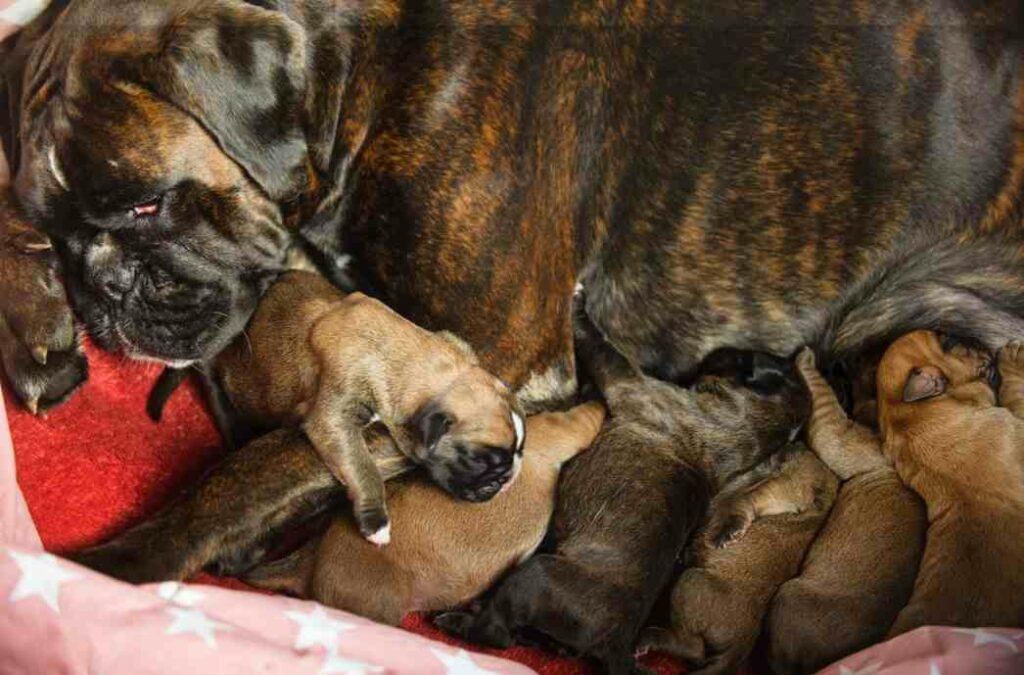
- Expect at least 15-60 minutes of rest time between births as your dog recovers her strength before pushing again. This is normal.
- Watch for signs of the next puppy entering the birth canal – more panting, anxious behavior, and straining.
- The pushing stage will repeat with each puppy, so be prepared to see active labor again.
- Keep track of the time between puppies being born – contact your vet if more than 4 hours pass between puppies.
- Count each placenta passed to ensure your dog delivers the same number of placentas as puppies whelped.
- Tie off and cut each puppy’s umbilical cord after checking they breathe okay.
- Let the mother clean off and nurse each puppy after birth. Assist only if needed.
- Make sure all puppies are nursing and being cared for by mom post-whelping.
- Weigh each puppy on a gram scale to monitor weight and health after birth.
- Allow your dog to rest undisturbed between puppies until her labor starts again.
Stay patient and keep monitoring until all puppies have arrived safely! Contact your vet immediately if you have any concerns.
Common complications that can arise during canine labor and delivery
- Dystocia – Labor stops, or the puppy gets stuck in the birth canal. This requires gentle assistance to reposition the puppy or veterinary intervention.
- Uterine inertia – Labor slows, or contractions are too weak to deliver puppies. May need medications to strengthen contractions.
- Breach birth – Puppy is positioned incorrectly with feet or rear exiting the birth canal first. Requires repositioning puppy.
- Stillborn puppy – The puppy is born deceased due to complications. Requires immediate veterinary care to save other puppies.
- Retained placenta – All afterbirths are not expelled after whelping. It can cause fatal infection, so it needs prompt veterinary treatment.
- Postpartum hemorrhage – Excessive bleeding from the vulva after birthing puppies. Requires emergency medical intervention.
- Eclampsia – Abnormally low blood calcium in the mother dog. A life-threatening condition requiring IV calcium.
- Mastitis – Painful infection of the mother dog’s mammary glands. Needs antibiotic treatment.
Monitor your dog closely during and after whelping, and don’t hesitate to call your veterinarian if any concerning signs develop. Prompt treatment is vital for complications.
Do dogs have a discharge before labor?
Yes, it’s common for dogs to have vaginal discharge before going into labor.
Here are some details on regular vs. abnormal discharge:
- Normal: A thick, clear, or slightly bloody mucus discharge 2-3 days before labor starts is normal. This signals changes in the cervix as it prepares to dilate.
- Normal: Green/dark brown discharge during active labor. This indicates placental separation after each puppy is born.
- Abnormal: A foul-smelling, pus-like, or black discharge before labor could indicate infection. Requires prompt veterinary attention.
- Abnormal: Significant red blood discharge before labor could indicate placental abruption or complications. Seek emergency vet care.
- Abnormal: Excessive bloody discharge after whelping may indicate hemorrhage or retained placentas. Needs immediate treatment.
Monitor the color and odor of your dog’s discharge leading up to whelping. Seek veterinary advice if you notice anything abnormal, as it could indicate a serious health issue for the mother or puppies. However, some discharge is expected as part of the labor process.
Do they leak before giving birth?
Yes, it’s common for a dog’s “water to break” and start leaking fluid before giving birth.
Here’s what to look for:
- A few days before labor, you may notice a clear fluid discharge as the cervix dilates. This is normal.
- More significant leakage of fluid indicates labor will begin within 24 hours. This is the amniotic sac rupturing.
- Once strong contractions begin, a gush of fluid will often come out as the puppy moves down the birth canal.
- A greenish discharge after the puppy is born is also expected and indicates placental separation.
- The mother dog may deliberately break the amniotic sac with her teeth to stimulate labor.
Monitor your dog closely as her due date approaches. Increased vaginal discharge is a clear sign whelping will start soon. Don’t be alarmed by fluids leaking, as this is all part of the normal labor process. Contact your vet if you have any concerns.
Do female dogs usually give birth at night?
Dogs often whelp their puppies at night, but daytime births are also common.
Here are some points about timing:
- Many dogs start active labor in the late evening or night due to feeling most secure and comfortable at that time.
- However, labor can begin any time of day. Contractions and the birthing process follow the dog’s biological rhythm.
- If allowed to follow their instincts, most dogs will give birth in the middle of the night or early morning.
- But for domestic dogs, giving birth during the daytime is not dangerous. Safety concerns do not constrain the timing.
- First-time mothers often whelp in the day, while more experienced dogs may wait for the night.
- The most important thing is for owners to be patient and allow the dog to control the timing herself.
While an evening or overnight whelping may be typical, don’t be surprised if your dog goes into labor at any hour. Be flexible since the process is unpredictable! Just provide a safe space whenever labor starts.
www.puppiesdiary.com
Conclusion
In summary, monitoring your pregnant dog closely in the final days and hours before labor will give you clear signs that whelping is imminent.
Recognizing physical and behavioral changes such as nesting instinct, temperature drops, appetite changes, enlarged mammary glands, discharge, and strong contractions will help you pinpoint when your dog is nearing active labor so you can offer support.
While most dogs undergo natural births without incident, be prepared for potential emergencies by having your veterinarian’s number handy and puppy birthing supplies on standby.
Keep an eye out for abnormal discharge, prolonged labor, or any indications of distress in the mother dog or puppies. With preparation and awareness, you can ensure your dog has the smooth, safe whelping she deserves. It is better to keep away your male dog from newborn puppies.
The incredible natural process of dogs giving birth is an experience like no other for an owner. Stay calm, trust your dog’s mothering instincts, and be ready to nurture a beautiful new puppy family!





